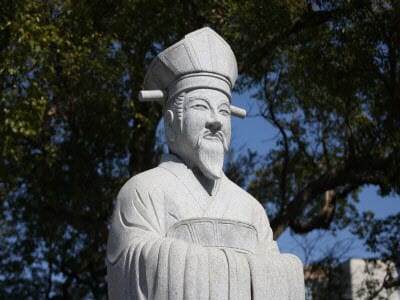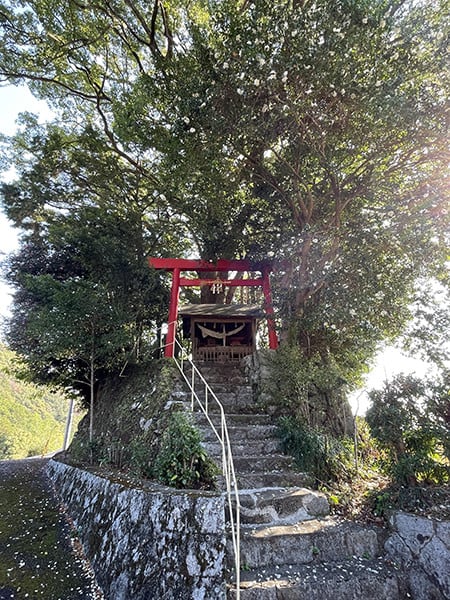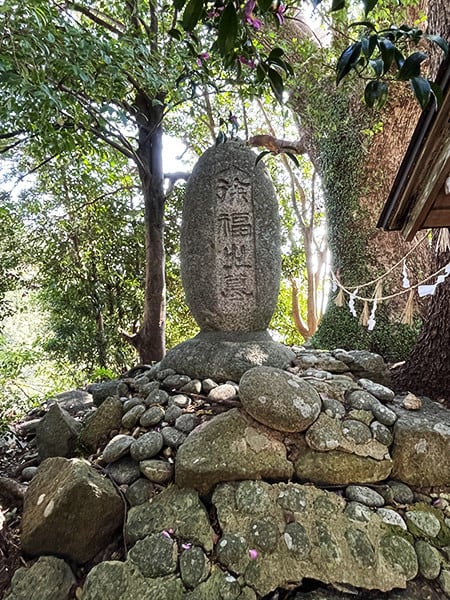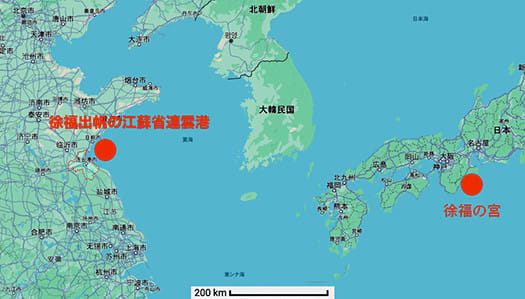


能登地震発生後10日を過ぎて実にたくさんの映像情報がもたらされてきている。能登には訪問経験があってまったく、言葉もない。とくに震源の珠洲市からはかなり離れた金沢市の北方隣接の「内灘」地域の震災状況には、おどろかされた。道路交通が非常に困難な地域であり未曾有の状況も、徐々に明らかになってくるのだろう。まことに震災の恐怖を感じざるを得ない。災害について、住宅建築全体が今後の対応を迫られていく趨勢は間違いないだろう。社会の復元力が試されていくことになるのだろう。
さて、きのう書いた「徐福の宮」について、そこに至る道路状況についての体験が強烈で一気に書いたので、肝心の徐福伝説について触れていないことに気付いてしまった(泣)。
ということで遅ればせながら。上の写真のように三重県熊野市波田須の海岸線近くにこの社は特徴的な1本樹木を背景として建てられている。波田須地域全体がまことに狭隘な地形になっているけれど、この御宮はちょっと盛り上がった場所に位置している。
祭神とされているのは中国・秦の時代(紀元前221年に史上初めて中国全土を統一、紀元前206年に滅亡。始皇帝で知られる。)に、始皇帝から「不老不死」の妙薬を探し出す命を受けて、3000人の童男童女による船団を連ねて「東方」に向かったという人物。その荒唐無稽な内容から根拠のない俗説とされてきたけれど、1982年になって中国の江蘇省連雲港市かん楡(かんゆい)県において「徐福」村が発見され徐福が実在の人物として学術研究会で発表された。その後これを契機に秦・漢代の造船所跡などの遺跡も発見されて、当地では徐福生誕の地と情報拡散され観光資源化されてきているという。徐福の出帆、出発は紀元前219年と擬定されているとのこと。



この伝説は不思議なことに日本各地域に徐福伝説として痕跡を残していて、その最たるものが熊野のこの地にあるのだ。今回の探訪の趣旨からは少し外れるけれど、神武帝と同様に「海をわたってきた」説話の骨格は共通するので、興味は持たざるを得ない。歴史作家・安部龍太郎の「半島を行く」には現地で秦代の貨幣も出土した話も記されている。
熊野地域の中心、新宮市にも「徐福公園」が整備され市のHPにもこの伝承が掲載されている。以下要旨。
〜徐福一行はこの地に自生する「天台烏薬(てんだいうやく)」という薬木を発見しましたが、気候温暖、風光明媚、更には土地の人々の暖かい友情に触れてこの地を永住の地と定め、土地を拓き農耕・漁法・捕鯨・紙すき等の技術をこの地に伝えたと言われます。<中略>日本でも徐福渡来の伝承地がいくつかあり、古くから地域伝承を育み、さまざまな文化が形づくられてきました。特に熊野には徐福渡来の地として数々の伝承・史跡が残り鎌倉時代には文献に出てきます。〜
紀元前219年当時と言えば、日本は弥生時代。もちろん文字記録などはない時代。真贋はもちろん定かではないけれど、どうして熊野にはこういった伝承が根付くのか、不思議な符合と言わざるを得ない。
English version⬇
The Legend of Xu Fu" in Qin, China, which remains in various places in the archipelago.
Yesterday, I forgot to write about the important Xu Fu legend. The legend of Xu Fu, which dates back to 219 B.C. in the Qin Dynasty of China, has been preserved as a palace in Kumano. The palace is located in Kumano.
It has been more than 10 days since the Noto earthquake and a lot of visual information has come in. I have been to Noto before and have no words to describe it. In particular, I was astonished by the earthquake situation in the Uchinada area, which is located in the northern part of Kanazawa City and is quite far from the epicenter of the quake in Suzu City. Road traffic is extremely difficult in this area, and the unprecedented situation will probably become clearer gradually. One can't help but feel a real sense of fear about the disaster. There is no doubt that housing construction as a whole will be forced to respond to the disaster in the future. The resilience of society will be put to the test.
I wrote about "Xufu's Palace" yesterday because I had such an intense experience of the road conditions leading to the palace that I realized I had not mentioned the Xufu legend, which is the most important part of the story (tears).
So, I am late to the party. As you can see in the photo above, this shrine is built near the coastline in Hadasu, Kumano, Mie Prefecture, with a distinctive single tree in the background. The entire Hadasu area has a very narrow topography, but this shrine is located on a slightly elevated site.
The shrine is dedicated to the god of worship during the Qin Dynasty in China (known for the first unification of China in 221 B.C., followed by the fall of the Qin Dynasty in 206 B.C., and the first emperor of the Qin Dynasty, Shi Huangdi). It was destroyed in 206 B.C., known as the First Emperor of China). In the Qin Dynasty (221 B.C., the first time China was unified in 221 B.C., and it was destroyed in 206 B.C.), a fleet of 3,000 men, women, and children headed for the East in search of a miracle medicine that would make them immortal. Although this wild and ridiculous story has been considered a myth with no basis in reality, in 1982, a village named "Xu Fu" was discovered in Kanyu County, Lianyungang City, Jiangsu Province, China, and Xu Fu was announced as a real person by an academic research group. This led to the discovery of the ruins of shipyards and other relics from the Qin and Han dynasties, and information about Xu Fu's birthplace has been spread in the area, making it a tourist resource. It is believed that Xu Fu set sail and departed in 219 B.C.
Curiously, this legend has left traces in various regions of Japan as the legend of Xufuku, the best example of which is found here in Kumano. Although it is a little out of the scope of this visit, it is of interest because, like the legend of Emperor Jinmu, it shares the same framework of the "crossing the sea" legend. In his book "Going to the Peninsula," history writer Ryutaro Abe mentions that coins of the Qin dynasty were also excavated in the area.
In Shingu City, the center of the Kumano region, a "Xufuku Park" has been established, and the city's website also carries this legend. The following is the gist of the story.
〜It is said that Xu Fu and his party discovered a medicinal tree called "Tendayaku," which grew wild in this area, and that the warm climate, scenic beauty, and warm friendship of the local people made this place their permanent home, where they cultivated the land and introduced farming, fishing, whaling, paper making, and other skills to this area. <In Japan, there are several places where Xu Fu has been handed down from generation to generation, and local traditions have been nurtured and a variety of cultures have been formed since ancient times. In Kumano, in particular, there are numerous legends and historical sites that can be traced back to the Kamakura period (1185-1333), and the story of Xufuku's arrival can be found in literature. 〜The first time in 219 B.C.E.
In 219 B.C., Japan was in the Yayoi period. Of course, there were no written records. Although the authenticity of this story is not certain, it is a curious coincidence that this kind of folklore has taken root in Kumano.



















